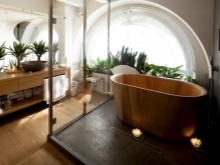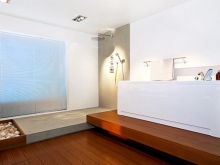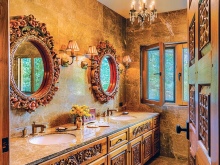Eastern style bathroom
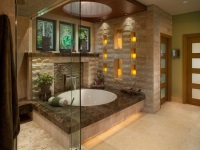
Features
The Oriental style is multifaceted and diverse, just like the countries that are located in the most mysterious part of the world. Restrained Japan is characterized by austerity and minimalism in everything, and the Turkish interior is impossible to imagine without a luxurious, rich decoration. However, there is something that unites the different directions of the oriental style - a commitment to tradition and the desire to embody the national colors in everything - from the design of the plumbing to the way of arrangement of furniture.
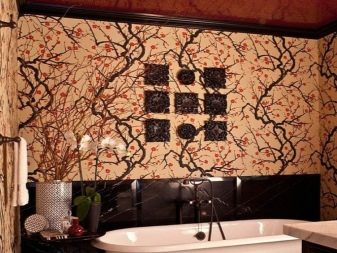
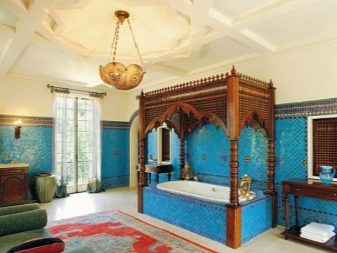
Other interior features typical of most oriental styles include:
- A rich color palette, combining bright and light shades;
- mainly natural materials in the finishing of walls and furniture;
- the national patterns as decor elements;
- furniture, decorated with artistic carvings and/or imitation of precious stones;
- artistic paintings on walls and other surfaces;
- colored mosaics of stones and ceramic tiles on walls and ceilings;
- zoning of rooms by means of building structures - arches, columns, podiums, etc.
- Curtains and baldachins made of expensive, patterned fabrics.
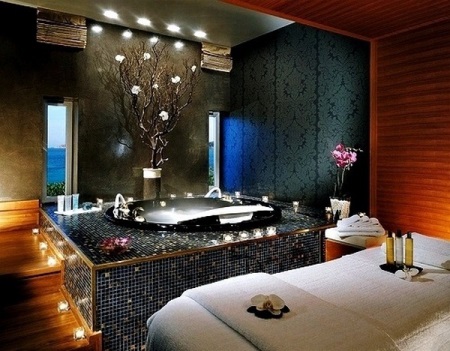
Pros
- Oriental style - a very broad concept that includes many sub-styles, quite different from each other. The bathroom, decorated in oriental style, can be both practical and laconic, and replete with all sorts of excesses. Therefore, among the wealth of styles that gave us the countries of the East, everyone will be able to choose something of his own.
- It is very interesting to work with the oriental style in the interior, because knowing the basics of design alone is not enough. In order to create an authentic oriental interior, you have to get acquainted at least superficially with the culture of your chosen country, its traditions, religion and other important points. So, in order to design a bathroom in the Chinese style, it is not superfluous to get acquainted with the teachings of Feng Shui.
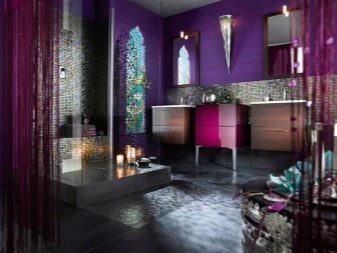

Who is suitable?
Not everyone likes the Oriental style. But even if you're excited about the exotic interiors of Turkish palaces or sushi bars, it does not mean that living in an apartment, furnished in oriental style, will be to your liking.
Oriental interior suits only those people who:
- They like an order and try to keep a certain place for every thing in the house - in fact the East gives a special meaning to each item of interior, and to break the established order, means to break the harmony of the house;
- they do not like agglomeration of furniture in the house: oriental people prefer to make do with the minimum quantity of furniture: cushions and mats instead of armchairs, chests for keeping things instead of cupboards and chests, etc;
- Prefer to sacrifice something of the interior objects or accessories for the sake of free space - the oriental style "likes" spacious rooms with lots of light and fresh air.
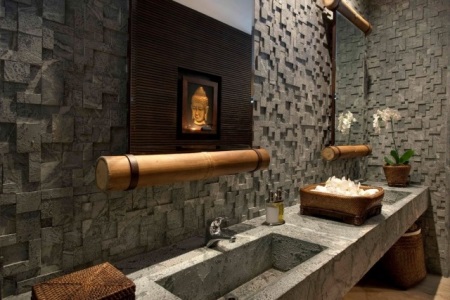
Popular subspecies of style
Consider the most common varieties of oriental style.
Arabian
Arabian style has ancient and rather strict traditions that combine religious injunctions, ancestors' way of life and folk crafts. So, according to Koran the artist has no right to depict anything alive, that's why in the Arabian craftsmen learned to create extraordinarily beautiful geometric patterns and ornaments of fantastic colors and religious texts.
The nomadic way of life forced the Arabs to give up excess furniture and to carry only the essentials on the road. Tents protecting from the scorching sun of the desert became a real source of inspiration for interior designers. Therefore, even in the bathroom you can safely place baldachins and air curtains.
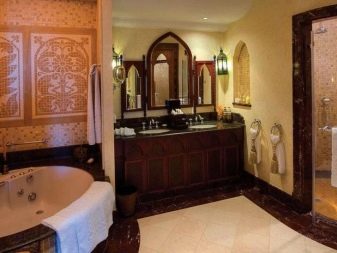
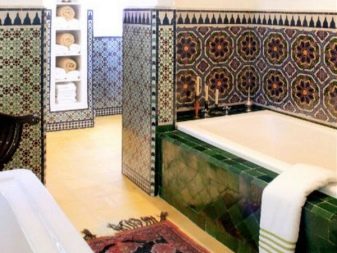
Arabian craftsmen are famous for their ability to create mosaics, carving delicate rhombi out of pieces of wood and covering them with mother-of-pearl. Such mosaics are used to decorate walls, columns or pieces of furniture. Another craft that is considered the "calling card" of Arab artisans is the weaving of colorful, patterned carpets. The more intricate the pattern, the more valuable the product.
In Arab tradition, carpets were used to cover all the surfaces in the house. In the bathroom, of course, it should not be done, a small traditional rug placed near the font is enough.
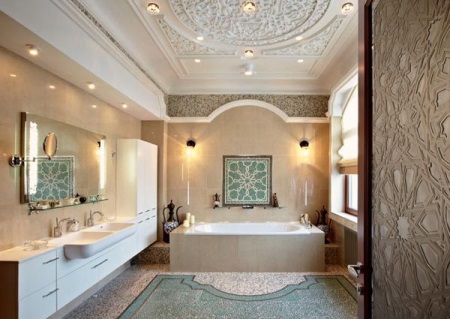
Japanese
In the Japanese tradition, the bathing procedure is given special importance, it becomes a real ceremony to restore lost energy and put the mind in order. This is why the bathroom is an important place in any Japanese home. The bathroom, just like any other room in a real Japanese apartment, should be ascetic and conducive to immersion in one's own thoughts.
The Japanese care about cleanliness of the body just as much as they do about cleanliness of the shower, so in addition to the font, the bathroom usually has a shower stall in which the first stage of cleansing - the actual washing away of dirt - takes place.
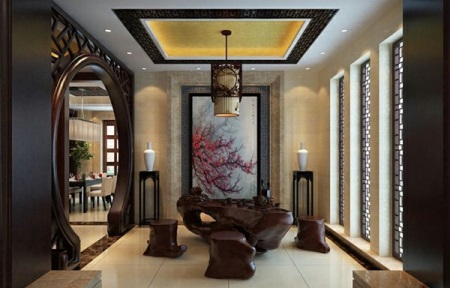
The traditional Japanese bathtub is a wooden basin. But, since our goal is not an exact recreation of the Japanese interior, you can do with a simple acrylic bathtub, supplementing it with a wooden or stone countertop. Finishing materials for walls, floor, furniture and plumbing should be exclusively natural; in addition to wood and stone, it can be ceramic, glass or bamboo. If metal, it should be aged.
The colors in which the Japanese interior is decorated should also be natural - sandy, brown, beige, milk. Red and green are usually used as bright accents.
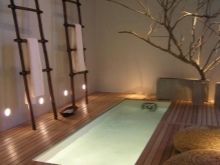
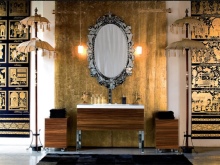
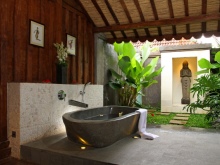
Mobile partitions made of bamboo or rice paper are a traditional element of Japanese interior design. They can be used to divide the room into functional zones or to separate the place for changing.
As accessories we choose live bonsai in pots, mats, mats, samurai paraphernalia, stone figurines and ceramic tableware.
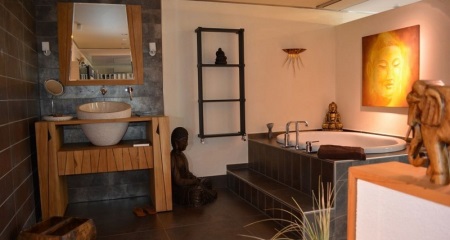
Egyptian
An Egyptian-style bathroom is a combination of simple geometry, clean lines and rich finishes. In the Egyptian interior designers embody all their knowledge of the history of this ancient land. The majestic pyramids, the vast desert, the mighty Nile - all this is reflected in the design and decorative elements of the room, decorated in the Egyptian style.
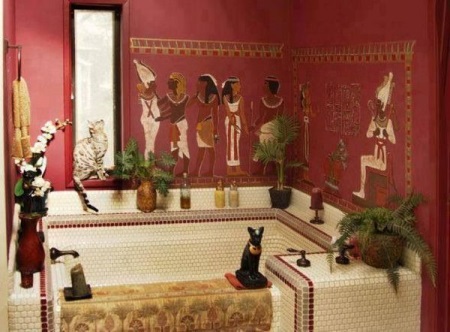
The walls can be painted with recognizable hieroglyphs, depicting mythical creatures and ancient gods. A colorful mural, executed in the typical "flat" manner of the ancient Egyptian masters can become the main decoration of the bathroom in the Egyptian style.
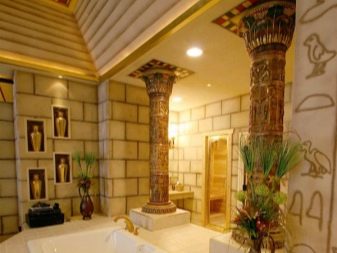
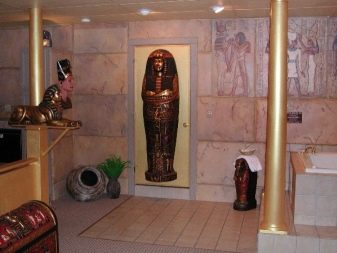
Gold is the main element of decor for the Egyptian bathroom, so there should be as much gilding as possible - on the walls, furniture, fixtures, etc. On the floor, a mosaic of traditional turquoise or blue is preferable. Other colors that designers recommend are yellow, beige, ochre, green. Complement the interior with souvenirs brought from travel, miniature pyramids, parchment scrolls, statuettes depicting pharaohs and Egyptian deities.
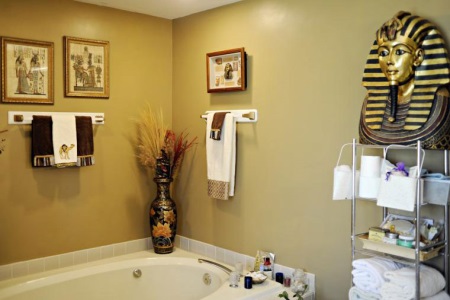
Turkish
The Turkish style is an offshoot of the Arabic style, so in general these two varieties of Oriental style are very similar, except that Turkey is characterized by more opulent interiors. If it is a bathroom it should have a stone floor and a large, beautifully decorated font. The most recognizable Turkish pattern is "cucumbers". Ceramic tiles on the walls, furniture upholstery and other interior elements can be decorated with this ornament.
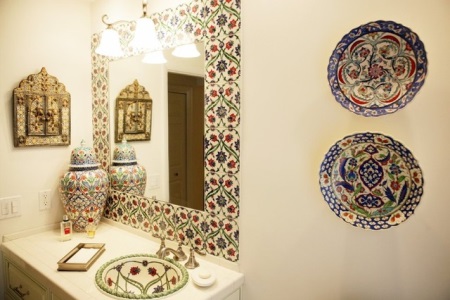
The color scheme consists mainly of warm colors, reminiscent of the sun, the sea and the rich vegetation of the Black Sea coast. Therefore, the light finish of the floor and walls should be combined with inclusions of yellow, orange, turquoise, azure and green colors. Traditional Turkish mosaics can be used as finishing elements.
Furniture in the Turkish bathroom should not be much, but it must be richly decorated - with inlays of rare woods, semi-precious stones or simply artful carvings.
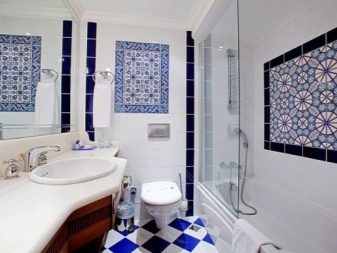
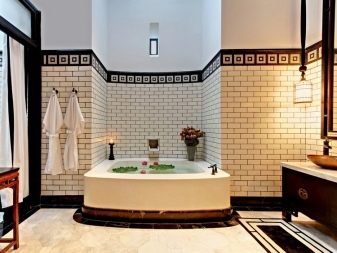
Moroccan
Morocco has become popular with our tourists relatively recently, and until then our ideas about this African country were very vague. Now, with Moroccan cuisine restaurants and exotic souvenir stores popping up everywhere, the Moroccan style interior has become quite a sought-after design trend.
The Moroccan style is characterized by the use of cult objects (ritual masks, etc.), jewelry carved from bone or wood or molded from clay, aged copper utensils, potted palm trees, bright feathers decor and other paraphernalia reminiscent of the hot desert and jungle.
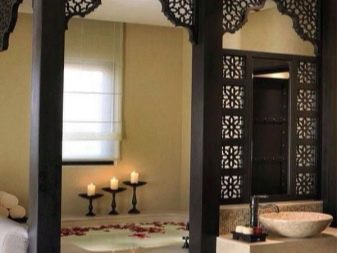
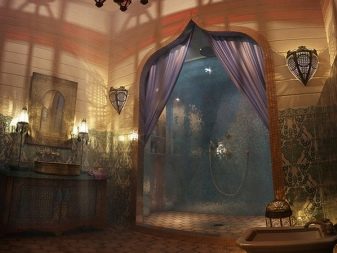
The Moroccan interior must have niches in the walls in the form of arches. The niches can accommodate a variety of interior items - plumbing fixtures, mirrors, furniture, etc. Door and window openings can also be made in the form of arches with a pointed arch.
In decoration and decorations the preference is given to wood, stone, ceramics, patinated metal and painted fabrics. The color palette is the same as in most Eastern styles: maximum natural, warm and sunny colors.
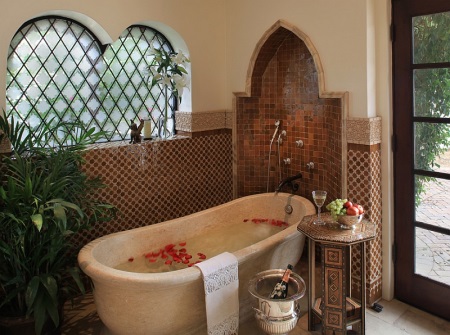
Chinese
The Chinese interior is almost as simple and laconic as the Japanese one, because these two cultures have a lot in common. The key importance here is given to the teachings of Feng Shui, one of the sections of which contains strict recommendations for the arrangement of furniture in the apartment.
In the Chinese bathroom, the font should be quite large and have the right shape - rectangle, circle or oval. Since we are talking about modern interiors, the material of the bath can be anything, you just need to find the right place for it and complement it with interesting accessories like a table top or matching the style of sanitary ware.
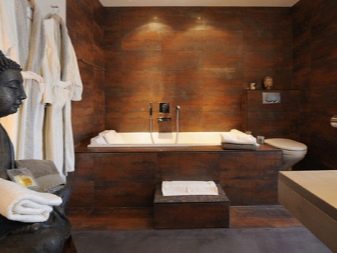
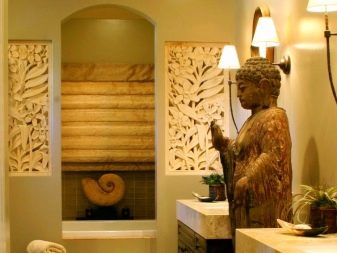
As in all national interiors, in the Chinese bathroom preference is given to natural materials. In addition to traditional wood and stone, it can be bamboo or ceramics. The favorite color in the Chinese interior is red. It can be complemented by white, gold, yellow, black and green colors. The most recognizable symbol in China is, of course, the dragon. The image of this mythical creature can be used as a recurring motif in the decoration of surfaces and furniture.

Indian
Perhaps the most bright and colorful of all the above mentioned oriental styles is the Indian one. Recall the scenes from Indian movies - it seems that all the colors of the world were gathered there! So if you decided to make an Indian bath in your home, be prepared for an abundance of decorations and a play of colors. However, you can make do with a less "extreme" version and use only some recognizable elements of Indian style.
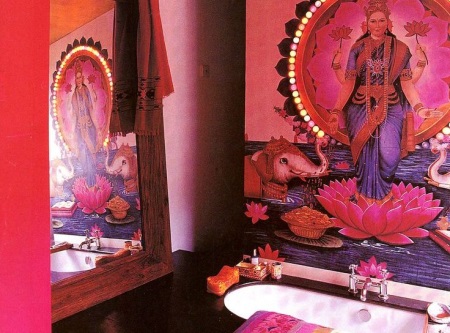
The Indian interior welcomes something that is absolutely inadmissible in Indian interiors: wall paintings with images of people, animals and plants that inhabit this wonderful country. For example, a panel depicting an elephant can be a key element in the decor, creating an appropriate mood at a glance.
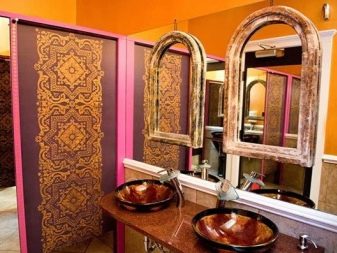
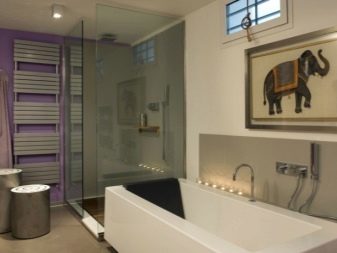
Carved wooden panels with intricate scrolls can be used in wall decoration or as a decorative screen under the bathtub. Elegant, carved furniture is a must for Indian interiors, so be sure to try to buy at least one cabinet made in this manner.
The color palette of the Indian interior is very rich, there are almost no restrictions, but the main focus is on the colors red, blue, green and yellow.
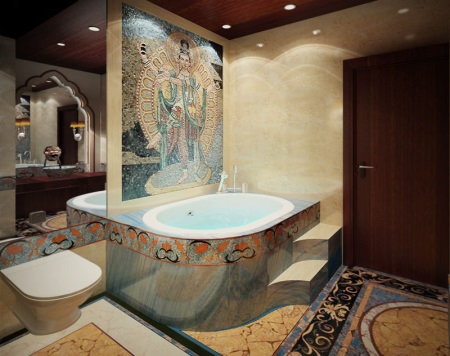
Tips
- Decorating the interior of the bathroom in the oriental spirit is a great way to find a use for knickknacks brought from travel or donated by loved ones. All sorts of figurines, vases, dishes, panels, shells - these are the little things that are needed to create a real oriental flavor.
- The interior should be thought out in advance. For inspiration, watch films that take place in Eastern countries. Notice what color combinations are used most often, how the homes of the locals are furnished. Even if they are just decorations, it is more important to convey the atmosphere than to maintain authenticity.
- Do not forget to zone the bathroom, using constructions, typical for the oriental style - portable partitions, arches, niches, columns, etc. It does not necessarily have to be massive, capital products, a skilful imitation is enough.
